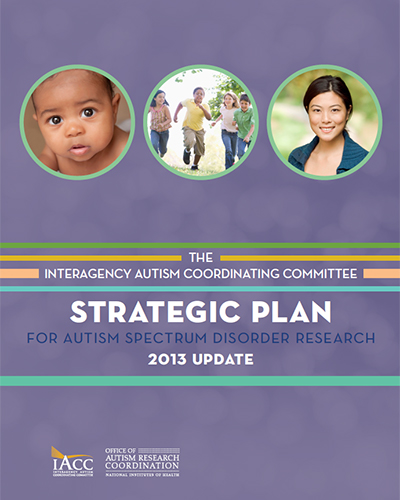IACC Strategic Plan
For Autism Spectrum Disorder Research
2013 Update
Question 1: When Should I Be Concerned?
When originally framed, Question 1 was directed toward identifying at-risk children by the age of 24 months to facilitate the greatest chance of successful early intervention. Scientific advances since then have shown that, in infants at high genetic risk for ASD due to having an older sibling with autism, symptoms of autism begin to emerge as young as 6 months of age in those who later develop ASD. Read more.
Question 2: How Can I Understand What Is Happening?
Over the course of the last several years, a great deal has been learned about altered neurodevelopment in ASD and a few interventions are in the early phases of testing. The knowledge base, however, is still not sufficient to support the long-term goal of personalized interventions. Objectives within Question 2 have also evolved as the science has provided more insight into the complexity of ASD. Read more.
Question 3: What Caused This to Happen and Can It Be Prevented?
The original version of the IACC Strategic Plan, published in 2009, identified nine objectives focused on research to identify and deepen the understanding of genetic and environmental causes of ASD. In 2010 and 2011, several new objectives were added. Read more.
Question 4: Which Treatments and Interventions Will Help?
A review of the state of the science in 2009 noted that many treatments were in use, but little rigorous evidence existed to support their safety or efficacy.1 At that point, the Committee identified intervention research needs from two quite different approaches. One approach, dependent on progress in the basic and translational research areas covered under Questions 2 and 3, called for novel, targeted interventions based on an understanding of the molecular mechanisms of ASD. Read more.
Question 5: Where Can I Turn for Services?
The 2009 IACC Strategic Plan, which was revised in 2010 and 2011, delineated nine objectives related to Question 5, which include four short-term objectives and five long-term objectives to address gaps in current policy and services research that will benefit the autism community. Read more.
Question 6: What Does the Future Hold, Particularly for Adults?
Positive, early childhood experiences can help increase the likelihood of better outcomes in adulthood. However, gains that were hard-won in childhood are at risk of losing traction during the period of new challenges associated with the transition to adulthood. The nature and availability of supportive services change dramatically as youth age out of eligibility for special education. Read more.
Question 7: What Other Infrastructure and Surveillance Needs Must Be Met?
The original IACC Strategic Plan, launched in 2009, was structured around only six Questions. In 2010, the IACC recognized that grouping the topics of research infrastructure, workforce, and ASD surveillance into a separate chapter would highlight these issues that are critically important to research success and help the Committee track investments and evaluate progress in this area in the same organized, rigorous manner that is used in the rest of the IACC Strategic Plan. Read more.











